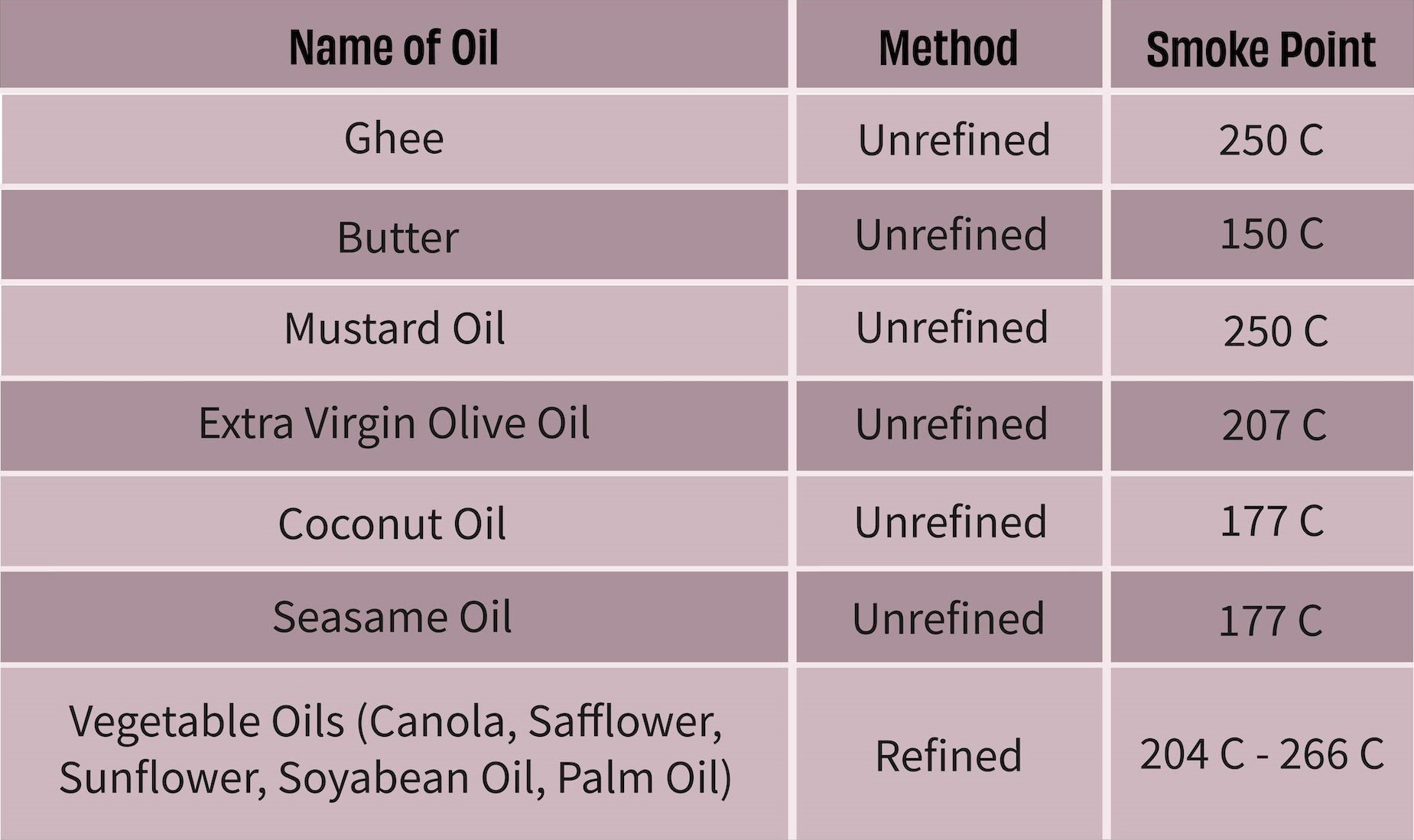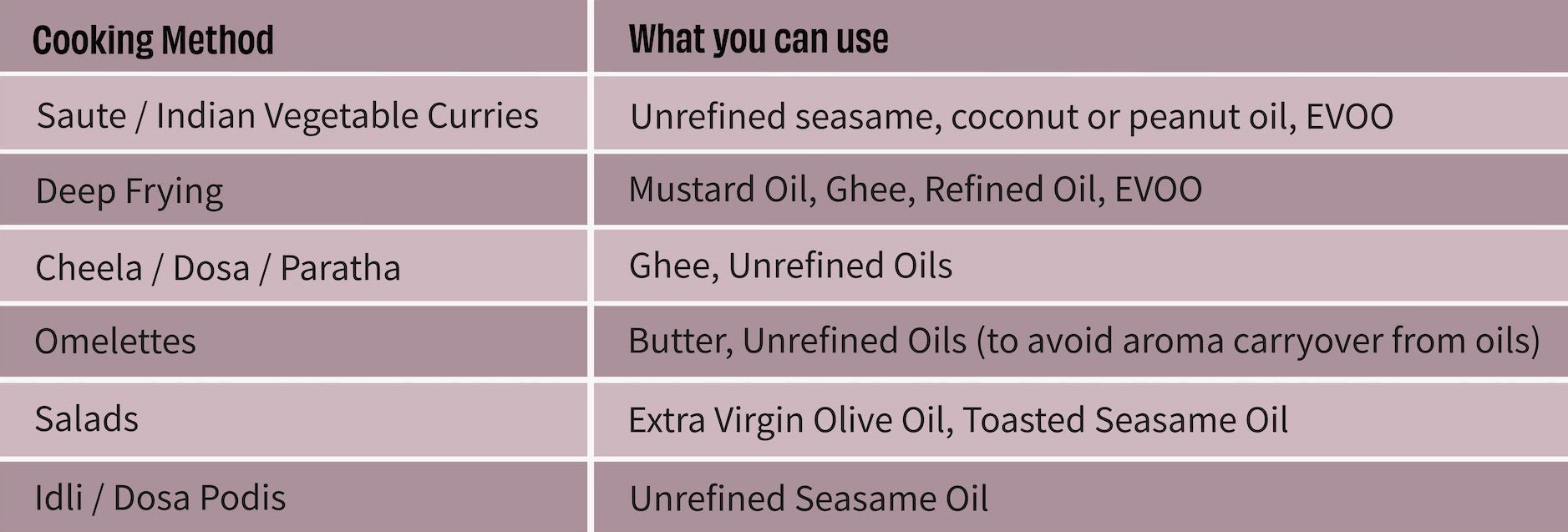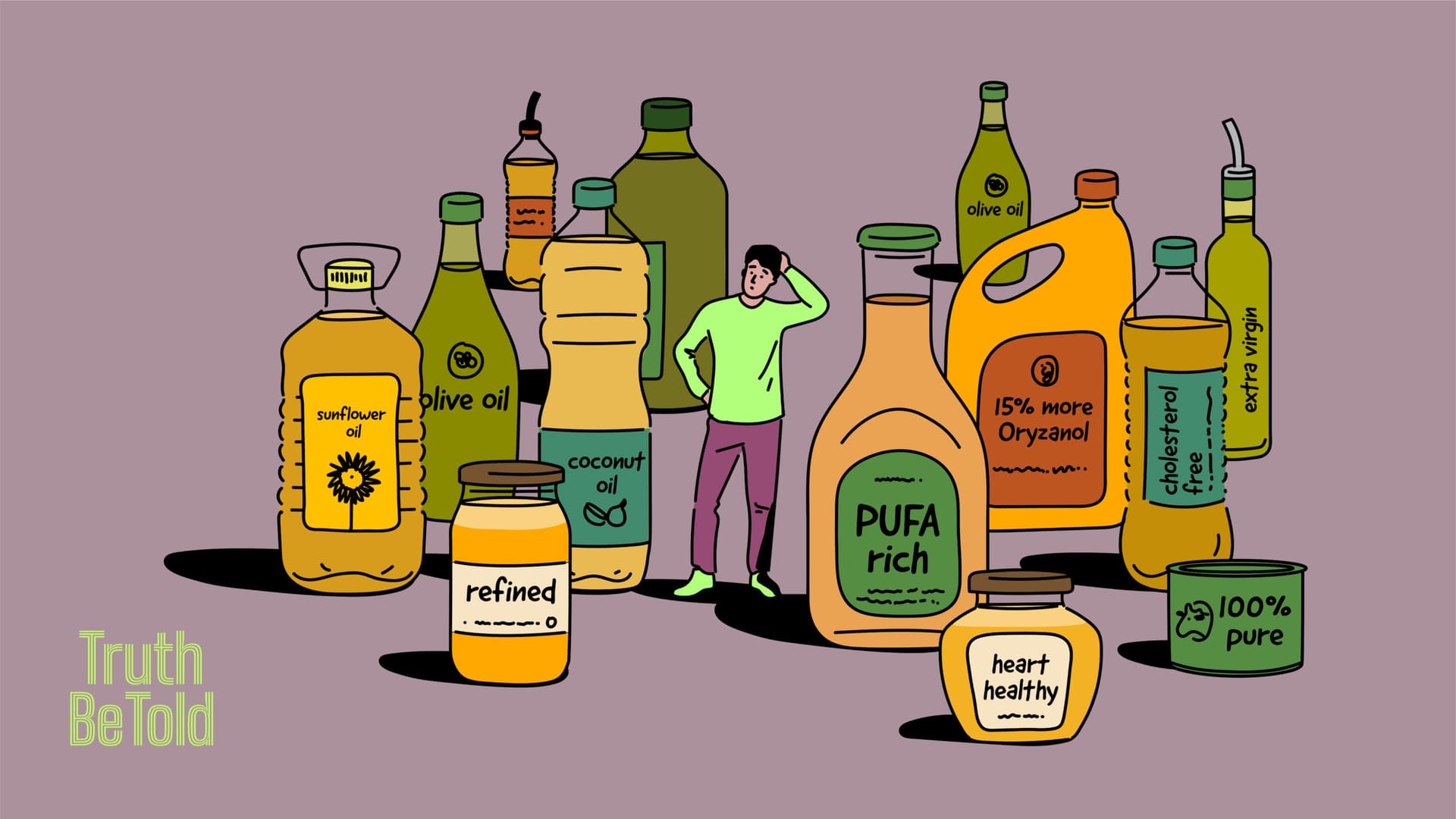8 tips to choose the right cooking oil
The definitive guide
The most trustworthy source of food and
fitness journalism in the country.
Should I use ghee, butter, olive oil, or sunflower oil?
What’s better: refined oils or cold-pressed oils?
What exactly does “heart healthy” and “cholesterol-free” mean? Should these labels dictate my choice?
Oil is essential for cooking: it carries flavour, transfers heat from stove to food, and stops food from sticking to the pan. But choosing one has become needlessly complicated. So many options.
Oils can be sourced from plants and animals. Plant-based edible oils are mostly extracted from seeds (sunflower oil), fruits (olive oil) and animal-based ones from milk (butter, ghee) and body fat (lard). And oils can be physically processed (cold-pressed, extra virgin) or chemically processed (refined).
It wasn’t always like this. Ask your grandma: how did she choose?
She will probably say that her go-to source was a local retailer who used a wooden chakki to extract oils. And will rave about the smell of freshly made oil and extol its culinary capabilities. She got it at its freshest in small quantities.
We are not living in that world anymore.
The oil grandma used came from the shortest possible supply chain: the retailer extracted fresh oil from the seeds and fruits bought from a local farmer and packaged it for local consumers.
The industrialisation of edible oil production changed this. Oils are now made in faraway factories and sit on retail shelves. It has expanded the length of supply chains, reduced prices, and spoiled us with choices.
Every consumer should know this: oils are chemically treated (or refined) to suit the needs of mass manufacturing and the long inventory cycles of modern production — not for our nutritional or culinary needs.
That context is crucial. While our grandparents’ lack of options led them to make good choices by default, we need to build a mental model to make smarter choices.
Science can’t alone inform what we choose. The decision calculus depends not only on an oil’s nutritional value and flavour profile, but also on on the cuisine, method of cooking, personal preference and cost. But science does offer a guide to choosing better.
I will first walk you through the essential basics, introduce my eight thumb rules for buying good oil, and end with what I use.
1. Oils are made up of only fats. But all fats are not the same.
There are four primary dietary fats in food: saturated fats, two types of unsaturated fats – monounsaturated fatty acids (MUFA) and polyunsaturated fatty acids (PUFA) — and trans fats.
Oils contain a combination of fats, mostly distributed between saturated and unsaturated forms. Trans fats is usually present in only trace levels in oils. Trans fats can be both naturally occurring or artificially made.
The breakup of the fats in the oil matters.
Approximate Fatty Acid Composition of Edible oils (g/100g)

Source: Selecting healthy edible oil in the Indian context (Pubmed)
Spend a minute with this table and see the difference: coconut oil is rich in saturated fats (89%), safflower oil is PUFA dominated (70%), and olive oil is 76% MUFA.
This chemical composition indicates stablility of the bonds inside the oil — and by extension, the stability of the oil itself. It also indicates how the body reacts to these oils after consumption.
Two thumb rules based on chemical composition:
Thumb rule #1: A healthy oil has less saturated fat and more unsaturated fats. And within the two types of unsaturated, more MUFA and less PUFA.
Classical studies have linked saturated fat and heart disease. And even though this science remains contested, most mainstream nutritionists recommend limiting saturated fats. MUFA rich oils (like mustard and olive oil) have higher stability — meaning it can resist reacting to oxygen and breaking down — and beneficial for heart health. Olive oil, in particular, helps maintain stable blood sugar levels and lowers inflammation.
Thumb rule #2: Avoid trans fats altogether. It increases the risk of coronary heart disease.
They can emerge naturally or as a byproduct of chemical processes. What matters to us: repeatedly heating cooking oils above 180C generates trans fats (more on that later) and that must be avoided.
India’s food regulator has capped trans fats at a 2% in foods and oils. And remember, this can be zero. So look for zero.
Know someone who repeatedly heats cooking oils? Help them
2. Know the smoke point
If you start seeing visible fumes billowing from the pan when you heat your oil for a long time, stop. You have reached its smoke point — the temperature at which the oil stops simmering and starts burning.
Smoke point is essential for deciding the utility of oil because different cooking methods need different temperatures: baking (180 C), frying (190 C), sauteing (163 C).

Oils with a higher smoke point can be used to achieve high temperatures necessary for crunchy, crispy deep fried textures.
Thumb rule #3: Smoke points matter, but having a higher one does not reflect higher quality.
Maximising smoke point makes sense only when using the oils as a high heat transfer mechanism (frying) — but not for other things like flavour or nutrition.
My recommendation: Oil selection based on smoke point and cooking method
3. Look at the production process
The method of extracting oil from their respective nuts, vegetables or seeds reveals its quality. There are different ways to do this — refined and unrefined are the two broad categories.
Most oils today are refined or purified, but don’t let the word purify mislead you. It may mean that the oil was treated with an acid, an alkali, or bleached — basically, all these are chemical processes, and the most commonly used chemical is hexane. Also, in making and refining oils, some fatty acids that don’t hold up well against heat turn into those dreaded trans fats. And this smell is so bad that a cleaning process has to take place to reduce the odour, which is called bleaching.
In addition, the refining process can’t distinguish between the good and bad components of oil. So yes, it does remove the stuff that can make oils go bad quickly (free fatty acids, pesticide residue, trace metals, etc.). But it also strips away the good stuff (vitamins, tocopherols, pigments, polyphenols etc.) So oil manufacturers add some of the good stuff back after processing.
So when unrefined oils can get the job done — as it did for our grandma — why use these highly processed refined oils?
Thumb rule #4: Avoid refined oils (to the extent possible) and prioritise minimally heat-processed unrefined oils.
This includes cold pressed or expeller pressed oils. In the market, you will find them under different names: raw, pure, virgin and extra virgin.
Popular refined oils include soybean, palm, corn, canola, sunflower and safflower. Among unrefined oils, mustard, olive, coconut and sesame top the charts. There are also partially refined oils like sesame oil that fall in the middle category — refined partially to extend the shelf life, but also not put through the harsh deodorising process.
I prefer unrefined oils because each is unique. Ghee, sesame, coconut and mustard — all have a wonderful aroma. You can smell a bottle of oil and identify which oil it is. They proudly retain their natural colour: olive oil is green, mustard oil is brown, and palm oil is red. They are also rich in nutrients.
Three tips for buying unrefined oils:
1. Don’t blindly buy unrefined oils. Instead, get it from reputed vendors with quality certifications and follow best practices.
2. Buy freshly squeezed oil in small quantities. Unrefined oils can get rancid over time due to the presence of trace elements.
3. Buy and store oils (especially cold pressed oils) in dark, solid containers. Light along with air and moisture can accelerate the rancidity in oils.
Help your family choose a healthy cooking oil. Share now
4. Beware of the marketeers
Don’t feel anxious looking at health claims made by manufacturers. Ignore all. As for anything you buy from a modern supermarket, label reading is essential.
Thumb rule #5: Ignore the front-of-pack claims.
Labels like “heart healthy” are liberally used without any apparent scientific basis. Yet, the regulator restricts only ten terms — “Cholesterol Fighter”, “Soothing to Heart”, for example — leaving ample space for the ingenuity of the marketing departments. Just ignore.
Take the “cholesterol-free” label: so many vegetable oils splash this claim. But this is meaningless because all plant products are cholesterol free. Only animal products contain cholesterol. All can be labeled “cholesterol free,” whether it is an ultra-refined cottonseed oil or hydrogenated soybean oil. But that is not a reflection of its quality — only an indication of its source.
Thumb rule #6: The ingredient list should only contain oil
Turn the back of the pack to read the ingredient list. Good oils only have one ingredient — the oil’s name. Or, in the case of blends, the name of all the oils added. And there are enough options available with just the oil.
Here is an example that you should avoid.

This product has two common ingredients many manufacturers add to edible oils: anti-foaming agent (INS900a) and synthetic oxidant (INS 319, or TBHQ).
Why is anti-foaming agent added in oil?
When you heat the oil multiple times, it will break down, foam and create toxic compounds. To stop the oil from foaming the defoaming agent is added . The problem? This removes your visual indicator that the oil is going bad — even though the oil will continue to degrade. You don’t want this.
Why TBHQ is added in oil?
INS 319, or TBHQ, is a synthetic antioxidant added to preserve oil’s freshness during transportation and storage. But look at the logic: you strip the oil’s naturally occurring antioxidants in the refining process and then replace it with a synthetic source to keep the oil from becoming bad.
In other words, you first put the oil through a harsh refining process to extend its shelf life and then add another preservative to extend its shelf life further. It seems a bit much. So avoid refined oils having TBHQ.
5. Flavour and aroma
As a cook, you can’t make a decision based on science alone. The choice depends on what you are cooking and your preference. Taste and flavour matter. Some cuisines rely on certain oil flavours: peanut oil is used in Asian food, and olive oil is used in the Mediterranean. And yet another reason to use unrefined oils is that they are much more tasty and flavorful than bland refined oils.
Thumb rule #7: Oil choice depends on cuisine
Think about tadkas in Indian cooking. You can use either ghee or oil — but the choice should depend on the recipe. For example, certain South Indian dishes like tamarind rice or vatha kuzhambu cannot be made with ghee. Only the flavour of sesame oil will suit those recipes. But a lot of Punjabi dishes use ghee. Its flavour compliments the paneer and the rich dal dishes the region offers. Similarly, Bengali tadka for dal is usually best with mustard oil only.
Help that friend who loves cooking make their dishes aromatic and healthy
6. Don’t reheat
People think refined oils can sustain multiple heatings without any problem. That’s not true.
Thumb rule #8: Do not heat oils repeatedly, especially if the oil appears black or thick or smells weird.
Reheating refined cooking oils causes them to break down and cause the formation of free radicals that create oxidative stress in the body. Unfortunately, it can also induce chemical changes in the oil and form of trans fats — the fats we always want to avoid. (Beware of outside vendors who reuse cooking oils non-stop throughout the day!)
At our home, if we are making vada or appalam, we use that batch of oil only once for deep frying. And once that is complete, we filter it out and use it up for tadka (much lower temperature) during regular cooking. So do not keep the same batch of oil for repeatedly frying over multiple days at high heat.
7. Use oil, not too much.
Oils are dense in energy and fat. For example, one tablespoon of olive oil contains 120 calories and 14 grams fat. Compare that with one egg: it has three times less fat (5g) and around 75 calories.
So the most important thing?
Use oil in limited quantities.
Whether traditional or refined, we consume too much oil as a country. The Indian Council of Medical Research recommends an average of 30 gm/day/person. Yet, our current consumption levels are almost double that.
8. What I do
Science can prevent us from buying bad quality, rancid oils. I hope this article helps you overcome doubts on buying oils and lets you focus on enjoying the aroma and essence of cooking with oils.
Here are the ways I love using the flavours of oil in my kitchen.
1. Unrefined sesame oil for lining idli plates, streaming over dosas and idli/dosa podis.
2. Traditionally unrefined sesame oil and virgin coconut oil for tadkas.
3. Mustard oil whenever I try Bengali recipes. Bengali cuisine fascinates me, and they use mustard oil extensively.
4. I use extra virgin olive oil for most western dishes — soups, pasta, salad dressings, etc.
5. While I try to reduce my dependence on animal products (personal choice), whenever my mother stays with me, she has to have ghee. She says, “Rasam is only rasam if you tadka it with ghee.”
6. When we deep fry foods at home, on rare occasions, we use EVOO or ghee or mustard oil. But that batch of oil is used only once for deep frying. Once that is complete, we filter it out and use it up for tadka (much lower temperature) during everyday cooking.
About the author: Swetha Sivakumar is an industrial engineer, a mom, a food researcher and writer. She writes a weekly column on food for the Hindustan Times and blogs at Upgrade My Food
If you enjoyed reading this, check out the three-part series on cooking oils Swetha published on her blog. It dives deeper into science and history: part one, part two, part three.
Do tell us what you think. We will publish a select few responses in a special edition where readers get the platform to voice thoughts, feedback and criticism. Happy reading!
– Samarth (samarth@thewholetruthfoods.com)
More from Truth Be Told
I solved the mystery of the afternoon slump with CGM
Eight swaps to eat better everyday
Diwali indulgence won’t make you fat
What spikes your blood glucose?
Is your body ageing gracefully?
Should you count calories?
Letters to Editor: Reader Response 01
My experiments with sleep
Why weight loss is a rigged game
You can’t be ‘healthy’, if you don’t know what it means
Food and fitness journalism is broken. We are fixing it.

